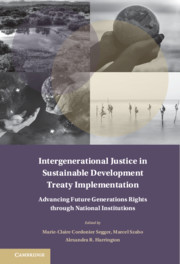 Intergenerational Justice in Sustainable Development Treaty Implementation
Intergenerational Justice in Sustainable Development Treaty Implementation Book contents
- Intergenerational Justice in Sustainable Development Treaty Implementation
- Treaty Implementation for Sustainable Development
- Intergenerational Justice in Sustainable Development Treaty Implementation
- Copyright page
- Contents
- Figures
- Tables
- Notes on Contributors
- Foreword
- Acknowledgements
- Abbreviations and Acronyms
- 1 Introduction
- 2 The Theoretical Framework for International Legal Principles of Intergenerational Equity and Implementation through National Institutions
- Part I Introduction to Treaty Law on Intergenerational Justice and Codifying Sustainability
- Part II Key Challenges in Domestic Implementation of Intergenerational Justice
- Part III Law and Policy Innovations for Intergenerational Justice
- Part IV Implementing Sustainability through National Institutions: Case Studies
- Part V Regional Trends in Intergenerational Justice
- Part VI Future Trends
- Afterword
- Table of Authorities
1 - Introduction
Published online by Cambridge University Press: 15 October 2021
- Intergenerational Justice in Sustainable Development Treaty Implementation
- Treaty Implementation for Sustainable Development
- Intergenerational Justice in Sustainable Development Treaty Implementation
- Copyright page
- Contents
- Figures
- Tables
- Notes on Contributors
- Foreword
- Acknowledgements
- Abbreviations and Acronyms
- 1 Introduction
- 2 The Theoretical Framework for International Legal Principles of Intergenerational Equity and Implementation through National Institutions
- Part I Introduction to Treaty Law on Intergenerational Justice and Codifying Sustainability
- Part II Key Challenges in Domestic Implementation of Intergenerational Justice
- Part III Law and Policy Innovations for Intergenerational Justice
- Part IV Implementing Sustainability through National Institutions: Case Studies
- Part V Regional Trends in Intergenerational Justice
- Part VI Future Trends
- Afterword
- Table of Authorities
Summary
It is the age of the Anthropocene. With far-reaching changes to economy and technology, society and the environment, humanity has gained the capacity to either foster or foreclose the quality of life for future generations. Through degradation of the Earth’s marine and terrestrial ecosystems and its climate, including the natural resources upon which all people depend, human civilization holds the potential to deprive billions of their rights to life, taking millions of other species as well. Particularly as social, economic and environmental transformations and impacts of the recent global COVID-19 pandemic become more apparent, a growing recognition of the risks and threats is slowly changing perceptions of humankind’s responsibility for its descendants. Since the 1972 UN Conference in Stockholm, numerous international policy declarations have reflected increasing concern for the need to promote a more sustainable development that can take into account the needs and interests of future generations, including the global adoption of the 17 Sustainable Development Goals (SDGs) and their 169 targets in 2015 by Heads of State in New York.
- Type
- Chapter
- Information
- Intergenerational Justice in Sustainable Development Treaty ImplementationAdvancing Future Generations Rights through National Institutions, pp. 1 - 15Publisher: Cambridge University PressPrint publication year: 2021


